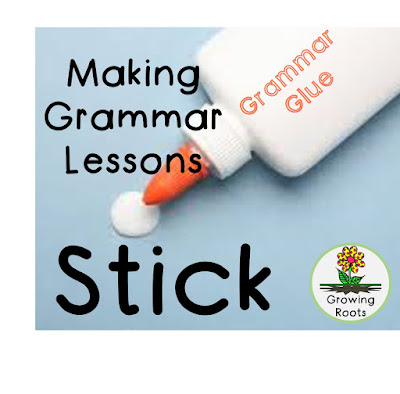My school is firmly tied to a basal series and I am expected to use just about every piece of that curriculum. Yet I run my literacy block as a Reader's Workshop/D5 model! How does that work? Sometimes it isn't easy, yet I'm very grateful to have flexibility on how I put the pieces together. Also, I have freedom to supplement as I see fit, and I supplement a lot - especially when it comes to teaching grammar and mechanics.
Oh how dry and boring are isolated worksheets. Here is a way to teach grammar and mechanics so it is applicable, meaningful and 'normal'. Teach it in context.
I look a week ahead in the basal scope and sequence. The week prior to it being taught in the basal, I introduce that concept via my daily Morning Message. I blogged about how I integrate content in my Morning Message here. For example, if I know that writing book titles is coming up, I'm sure to cover it in my Morning Message this week. I think of it like dripping information on my students. It gives kids exposure and practice for two weeks instead of one.
I share and explain a correct model. Keep it simple. "Look here. I underlined Little House on the Prairie? This is because we always underline the title of a book. It lets the reader know it is a title."
Later in the week I'll make a mistake.
"We have a problem here. Can anyone spot it?"
"Yes. I must underline When I Was Young in the Mountains. Who can explain why?"
A student will find, correct and explain the error in my message.
In addition, we discuss the concept as it relates to our daily mini lesson and read alouds.
"If I were to write a letter to my mom recommending this book, how would I write the title of this book?"
During the second week (the week it is targeted in the scope and sequence) I project a few worksheets from the basal during a writing mini lesson. We do it whole group so kids will become familiar seeing the concept presented different ways. In addition, I want them to know the format for assessment day.
Throughout the week however, I use these activity sheets.
I love these because they can be used with ANY text at ANY level and, most importantly, they focus on noticing and understanding the skills in context.
The top left is a skill anchor chart. It reminds students of the overall skill concept in bold. There are one or two examples to practice the skill.
The top right is a task card. This gives students instructions.
The bottom is an area for student interaction using their own text. A quick check lets me see who has mastered the skill and who needs reteaching.
These Grammar and Mechanic Sheets are very flexible! There is built in differentiation and are super for informal assessments.
1. Model a new sheet during a mini lesson after the skill has been introduced and taught. Work as a whole group.
2. Explain the three key pieces of the sheet whole group. Depending on student need, students work independently, with a partner or with direct instruction in a small group setting.
3. Use with the basal anthology or the basal readers or self-selected text.
4. Complete during guided reading, Word Work or Writer's Workshop.
5. Students project their 'findings' and share with the class.
6. Keep as a whole sheet or cut and glue into a Reader's Notebook.
If you'd like to try out a sample for free click here
Teaching grammar and mechanic skills in context helps concepts stick better with kids. How do you authentically engage students when tied to a basal series?





No comments:
Post a Comment
Let me know what you think!